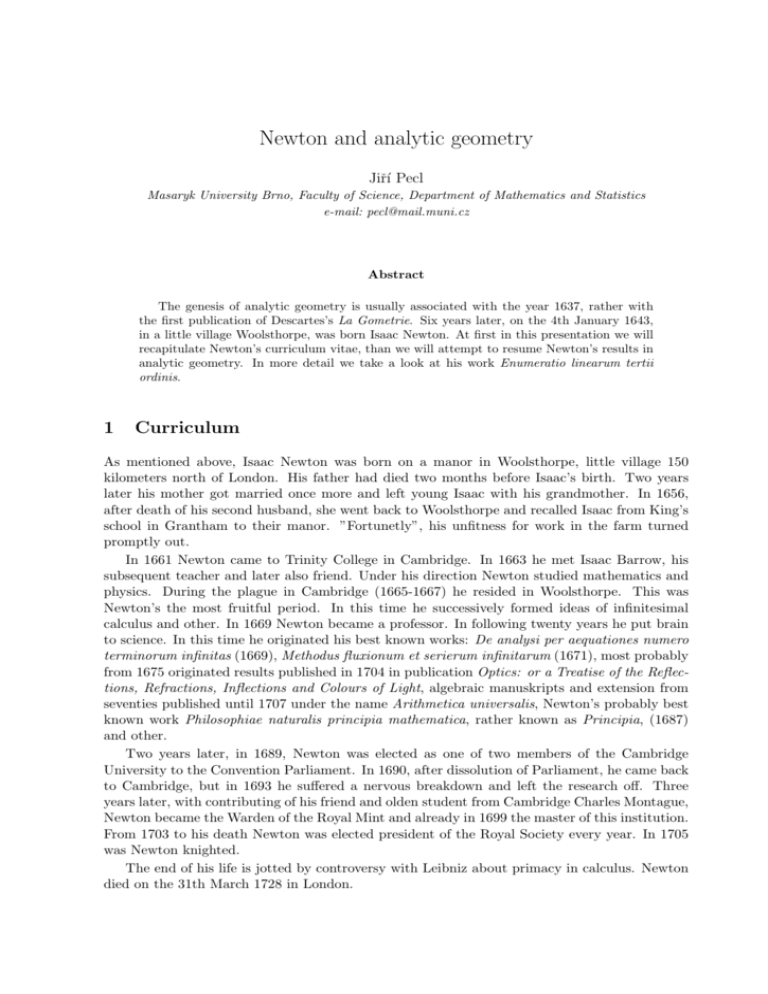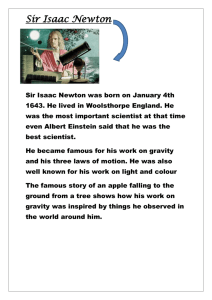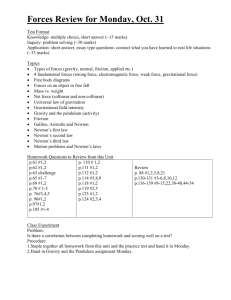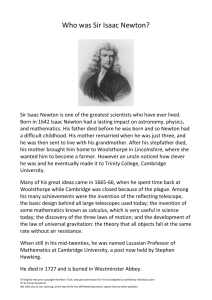Newton and analytic geometry
advertisement

Newton and analytic geometry Jiřı́ Pecl Masaryk University Brno, Faculty of Science, Department of Mathematics and Statistics e-mail: pecl@mail.muni.cz Abstract The genesis of analytic geometry is usually associated with the year 1637, rather with the first publication of Descartes’s La Gometrie. Six years later, on the 4th January 1643, in a little village Woolsthorpe, was born Isaac Newton. At first in this presentation we will recapitulate Newton’s curriculum vitae, than we will attempt to resume Newton’s results in analytic geometry. In more detail we take a look at his work Enumeratio linearum tertii ordinis. 1 Curriculum As mentioned above, Isaac Newton was born on a manor in Woolsthorpe, little village 150 kilometers north of London. His father had died two months before Isaac’s birth. Two years later his mother got married once more and left young Isaac with his grandmother. In 1656, after death of his second husband, she went back to Woolsthorpe and recalled Isaac from King’s school in Grantham to their manor. ”Fortunetly”, his unfitness for work in the farm turned promptly out. In 1661 Newton came to Trinity College in Cambridge. In 1663 he met Isaac Barrow, his subsequent teacher and later also friend. Under his direction Newton studied mathematics and physics. During the plague in Cambridge (1665-1667) he resided in Woolsthorpe. This was Newton’s the most fruitful period. In this time he successively formed ideas of infinitesimal calculus and other. In 1669 Newton became a professor. In following twenty years he put brain to science. In this time he originated his best known works: De analysi per aequationes numero terminorum infinitas (1669), Methodus fluxionum et serierum infinitarum (1671), most probably from 1675 originated results published in 1704 in publication Optics: or a Treatise of the Reflections, Refractions, Inflections and Colours of Light, algebraic manuskripts and extension from seventies published until 1707 under the name Arithmetica universalis, Newton’s probably best known work Philosophiae naturalis principia mathematica, rather known as Principia, (1687) and other. Two years later, in 1689, Newton was elected as one of two members of the Cambridge University to the Convention Parliament. In 1690, after dissolution of Parliament, he came back to Cambridge, but in 1693 he suffered a nervous breakdown and left the research off. Three years later, with contributing of his friend and olden student from Cambridge Charles Montague, Newton became the Warden of the Royal Mint and already in 1699 the master of this institution. From 1703 to his death Newton was elected president of the Royal Society every year. In 1705 was Newton knighted. The end of his life is jotted by controversy with Leibniz about primacy in calculus. Newton died on the 31th March 1728 in London. 2 Analytic geometry Newton’s main contribution to analytic geometry appeared surprisingly with the publication Optics in 1704, strictly speaking with its ”appendix” (which numbered nearly 200 pages). As well as René Descartes treated of analytic geometry in La géometrie, third appendix of his famous Discours de la méthode . . . , Newton’s work in analytic geometry (it is apparently characteristic for it) was also ”only” appendix - Enumeratio linearum tertii ordinis. This work was writen by Newton at least in 1676 and revised in 1695, but his aversion to release the results caused that this work appeared till 1704. This is the first work devoted solely to the theory of curves. In the Enumeratio Newton accounted meaning of coordinates and their use in determining curves by equations. In this work Newton described 72 kinds of cubics and also carefully drew them. We cannot help remarking, that all of them were plotted completely and correctly on for all four quadrants. He interpreted the degree of curve as the number of possible intersections of the curve with a stright line (in Enumeratio we can read: . . . et linea ordinis infinitesimi ea est, quam recta in punctis infinitis secare potest, qualis est Spiralis, Cyclois, . . . ). He devided curves as transcendental or algebraic in view of number of intersections with some stright line. In 1779 Samuel Horsley published Newton’s work (probably hadn’t published before) as Artis analyticae specimina vel geometria analytica. We can agree with Boyer, that ”The title of this treatise includes the phrase which later was to become the standard designation of Cartesian or algebraic geometry . . . ”, but it wasn’t for the first time. (The primacy probably belongs to Michel Rolle). More important is Newton’s usage of polar coordinates in analytic geometry. He used them in finding tangents to curves given analytically and for rectifation of them. Newton was also originator of bipolar coordinates. However Newton will always be mainly well known as a discoverer of kinetic laws and one of the authors of differential calculus. References [1] C. B. Boyer. History of analytic geometry. Dover, New York, 2004. [2] J. L. Coolidge. A History of Geometrical Methods. Dover, New York, 2003. [3] L. Nový, J. Smolka. Isaac Newton. Orbis, Prague, 1969. [4] I. Newton, J. Strling. Isaaci Newtoni Enumeratio linearum tertii ordinis [online]. c2007 [cit. 2008-9-13]. Available at www: http://books.google.com/books?id=pNI2AAAAMAAJ. [5] Newton biography [online]. c2000 [cit. 2008-9-12]. Available at www: groups.dcs.st-andrews.ac.uk/ history/Biographies/Newton.html. http://www-








